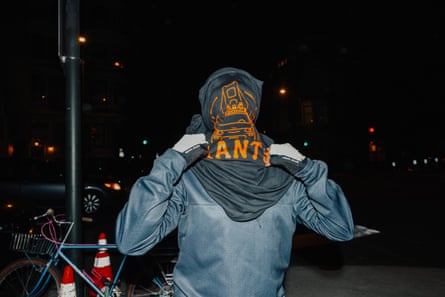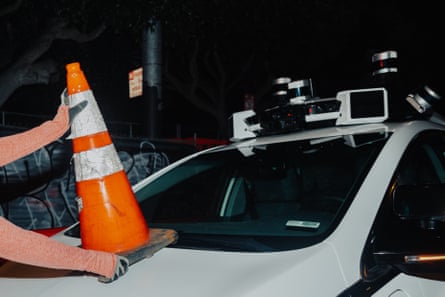It’s a typical Wednesday night in San Francisco, a wet fog coating the street-lit sidewalks of the Lower Haight neighborhood.
In the shadows of Duboce park, eight activists have gathered, bikes in hand. Their mission: to disable as many self-driving cars on the streets of the city as possible over the course of the next few hours. Their weapon of choice? A simple traffic cone, nicked from sidewalks and construction sites as they bike along.
The meet-up has been coordinated by the anti-car activist group Safe Street Rebel, which in recent months has waged a war on the self-driving cars that have dotted San Francisco’s streets since 2022. The group’s actions have been the subject of news articles and videos of their efforts, including detailed instructions on how supporters can disable the cars themselves, have gone viral on TikTok and Twitter.
The origins of the group’s tactics are murky, but at some point it was discovered that placing a cone on the hood of a self-driving car puts it into panic mode, shutting down the $50,000 vehicle until a human employee can come in person to get it unstuck.
Safe Street Rebel’s complaints about self-driving cars are multi-fold. The group has long campaigned for a less car-dominant San Francisco, promoting public transportation and advocating for pedestrian safety. It argues state funding and attention should be focused on public transit solutions, rather than on encouraging the use of personal vehicles, even self-driving ones. (Though the all-electric cars have been pitched as environmentally friendly, the group says constructing and charging the vehicles still poses environmental risks.) And it argues the widespread use of the vehicles poses a significant surveillance risk, as companies have already been hit with a number of law enforcement requests for footage collected by the cars’ cameras.

The group has ramped up its efforts ahead of a 10 August vote by the California public utilities commission on whether to allow driverless-car companies like Cruise and Waymo to expand their currently limited operations in San Francisco. If the expansion passes, Waymo and Cruise will be able to deploy more cars on to the streets at all hours and charge passengers for rides.
The group is not alone in its concerns. The San Francisco fire chief has warned that driverless cars have interfered with emergency operations nearly 40 times. According to a report from the California department of motor vehicles, there have been nearly 70 autonomous vehicle collision reports in 2023, including one incident in which a dog was struck and killed by a Waymo vehicle.
“We represent an extreme pole of the conversation that is strongly anti-car,” one activist, who the Guardian is not identifying due to potential legal or punitive actions, said. “I am not delusional, I know the city is not likely to ban robot cars. But what we are trying to do is move the needle in opposition to these vehicles. And it’s working.”
The city says it is seeking to address some of the growing concern around the autonomous vehicle firms ahead of the vote. Opponents say the companies have shown a lack of transparency, releasing sparing safety reports but no comprehensive data. “If this is a service for the public, the public should have data and be able to audit it,” one activist with Safe Street Rebels said.
Coning is a lot like fishing, it turns out. The activists wait around, chatting, watching cars drive around the park, scanning for one with the trademark 365-degree sensor atop its roof and a humming electric engine. Finally, a whirring Cruise car turns the corner. There is nobody inside. “Go, go go!” someone yells. An activist jogs forward and leaps in front of the vehicle, which automatically slams on its brakes to avoid impact. The cone is gently placed, and the car is now disabled, flashers on, inert on the San Francisco street. A human-driven car stops behind it and honks, the driver trying in vain to get the immobilized vehicle to move out of his way.

“Keep honking, it’s empty!” one activist laughs. After a car is disabled, the group departs. “We don’t like to stick around for when their employees arrive to fix it,” another activist explains. A group recently ran into trouble with Cruise employees who allegedly harassed the activists when they arrived to the scene of the cone. Drew Pusateri, a spokesperson for Cruise, said the company investigated the incident and found no evidence of inappropriate behavior from its team. After complaints about the incident went viral, there have not been any run-ins. But still, the group doesn’t think it wise to linger and they bike on to the next job. They leave behind a group of onlookers who have gathered on a nearby sidewalk, laughing raucously at the aftermath. “It’s a unicorn!” one says, snapping a photo of the coned vehicle.
The tech companies behind the push for autonomous vehicles are not as amused. Google-owned Waymo has threatened to call police on “anyone caught interfering with their fleet”, saying the coning is “vandalism and encourages unsafe and disrespectful behavior on our roadways”, according to a company statement previously provided to the Guardian. The company did not respond to additional requests for comment. Cruise, controlled by General Motors, has also condemned the activists’ efforts.
“Cruise’s fleet provides free rides to late-night service workers without more reliable transportation options, has delivered over 2 million meals to food-insecure San Franciscans and recovers food waste from local businesses,” said Pusateri. “Intentionally obstructing vehicles gets in the way of those efforts and risks creating traffic congestion for local residents.”
The activists dispute these characterizations, noting that under California law vandalism requires “damaging, destroying or defacing someone else’s property”. The cars are not damaged by the cones, only inconvenienced, they say.
The group says it operates with a loose set of ethical principles: they don’t target cars with passengers inside, only empty vehicles. They do not disable cars in the middle of intersections or high-speed thoroughfares where a stopped vehicle could be dangerous. Emphatically supportive of public transportation, the group takes special care not to block bus stops.
On this night, Safe Street Rebel hit about five cars – including one that seemingly was on a pre-determined path for other Cruise vehicles, creating a traffic jam of five disabled cars. The group says this was a record pile-up for them.

Many Cruise cars are painted with special themes and names, giving the endeavor tones of the Pokémon Go game – how many can you catch? The group places a cone on one vehicle emblazoned with the colors of the pan-African flag, a symbol of Black liberation in the United States. Pusateri said the branding was developed by an internal employee community group as part of Black history month. The car, which the company has named “Ebony”, sits disabled on the street alongside Alamo Square Park.
It’s late in the evening, and the group has one cone left in tow from their sweep of nearby streets. A car approaches the intersection and one participant – who says this is her first time attending an action – lies in wait. She hops off her bike, runs in front of the car, and cones it. “That’s my first cone! Baby’s first cone!” she yells. “It’s so fun, just a little pushback against a big movement.”
The group admits its tactics may need to evolve as the technology does. The cars are getting smarter, they say, swerving more quickly when they leap in front of them. And while Cruise has claimed the cone protest “has not had a meaningful impact on its fleet’s operation”, the group has noticed cars taking different routes to avoid them. But ultimately, they aren’t worried.
“If they move off one road, we just go to the next,” one activist said. “They can’t hide.”

